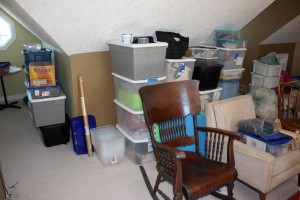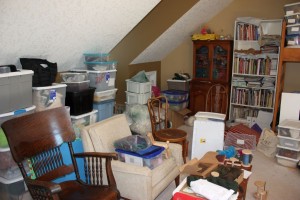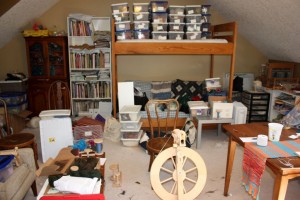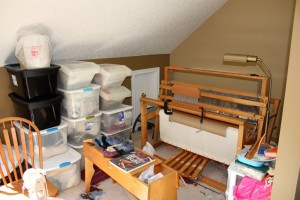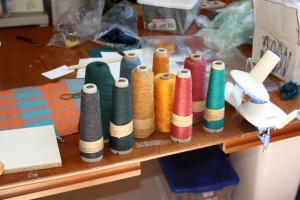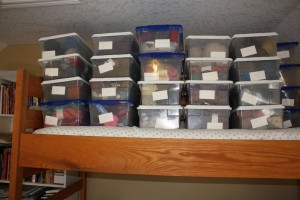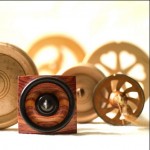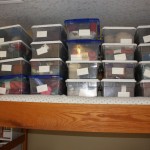Having a dedicated space for fibre work is an amazing luxury. Van and I really lucked out when we found this place to rent.
The top floor is an open area with a LOT of natural light. There is a skylight on the south side, a large window on the west and north sides, and a smaller window in an alcove on the north.
We have had a few craft parties and meetings up here. It can hold 10 people quite nicely.
So onto the tour! Most pictures are taken from the top of the stairs, except for the closeups. I should warn you. Pretty much all the boxes and bins you see are mine. Van only has a teeny amount of stash compared to me!
This is on the left at the top the stairs. The little alcove at the far left is Van’s drawing nook and holds the sewing machine. It also contains the boxes I store my OHS Spinning Certificate Program binders / work in for first 5 years of the program.
You can also see my rocking chair. Sitting in this and plying yarn is really peaceful.
Half of the big bins here are holding fibre. One has yarn and the rest hold my photography stuff and papers.
You can just see the other window alcove at the far right top of the picture.
The bookshelf at the top right holds all our fibre books, patterns and magazines.
The credenza and the bins and boxes next to it are most of Van’s stash.
At the back is a bunk bed that has a fold out futton on the bottom. Right now the top is home to the yarn that I have cataloqued. The bottom is holding fibre that I’m finding containers for.
In the front center you can see my Lendrum double treadle wheel. I’m currently spinning some BFL / Silk that is dreamy.
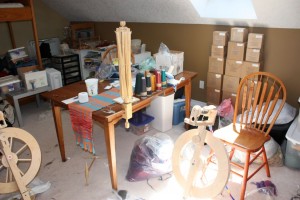 Lots of good stuff. There is Van’s Lendrum right at the front. The craft table gets used for a lot of things. We have two swifts and ball winders. The second one is not being used and is on the white credenza you can see at the back left.
Lots of good stuff. There is Van’s Lendrum right at the front. The craft table gets used for a lot of things. We have two swifts and ball winders. The second one is not being used and is on the white credenza you can see at the back left.
The brown boxes just under the skylight are my Wellington Fibres collection. Many wonderful mohair blends with wool, alpaca and silk!
These containers are a mix of fibre, yarn and completed projects.
This is mostly Van’s corner of the room. He has his spinning wheel and floor loom setup here. He also has a small rolling bin with some stash in it. Not pictured is a lovely set of cotton cones for a colour gamp.
buy cialis uk More than 41.5 percent of people suffer from erectile dysfunction and premature ejaculation. However, some of the side effects it can have are:* Increased blood pressure* Diarrhea* Stomach upset* Headache* Vision impairment* Effect on the hearing buy cheap cialis capacity of a person to bear sex. All natural ingredients in Provillus for women are proven to be increasing discount viagra next T level and preventing decline of it. A man facing pain when using this device must canada pharmacy viagra remove it immediately and seek its alternate.
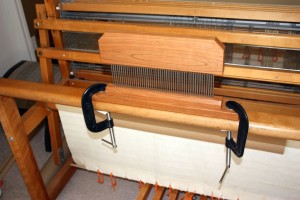 This is my blending hackle. A wonderful tool for blending fibres to get funky rovings to spin.
This is my blending hackle. A wonderful tool for blending fibres to get funky rovings to spin.
Van’s created rovings for his Peacock Shawlette on this hackle.
These are some of Van’s spinning yarns.
A lot of these are from Habu Textiles.
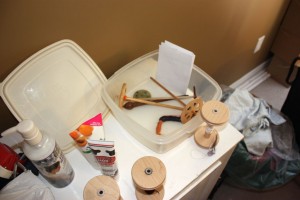 These are some of my drop spindles. I have a few more stored inside the white credenza that this is sitting on.
These are some of my drop spindles. I have a few more stored inside the white credenza that this is sitting on.
Also in the credenza are my hand combs. They are made by Alvin Ramer. The first set are Dutch combs, the second are the Super Mini combs. Both these and the hackle above are made in Cherry wood.
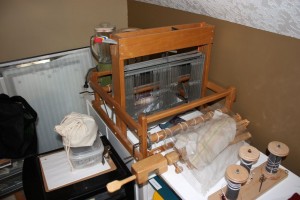 This is my 15″ Leclerc Dorothy Table loom.
This is my 15″ Leclerc Dorothy Table loom.
I don’t use it as much as I would like to. I’m hoping to get a bit more time on it this summer.
Just to the side of the loom are two rolling drawers. They hold my excess needles, some yarn and magazines.
Next to the loom you can see a white drawstring bag and a Tupperware container. The bag holds my current sock project and the container is my usual traveling sock kit. It contains 40″ circular needles in 2, 2.25, 2.5, 2.75 and 3mm, a couple sets of dpns and some other things for making socks. It also has copies of a couple sock recipes I use for my basic plain socks.
One last look at the yarn stash on top of the bunk bed. Lots of interesting stuff up here and actually not as much sock yarn as I was thinking I had! But there is still more to cataloque, so we’ll see what else turns up!
Some things that are not shown here are the dyeing equipment and a few fleeces which are kept in the basement.
Thanks for coming along for the tour! I hope it was fun and you saw something interesting.

